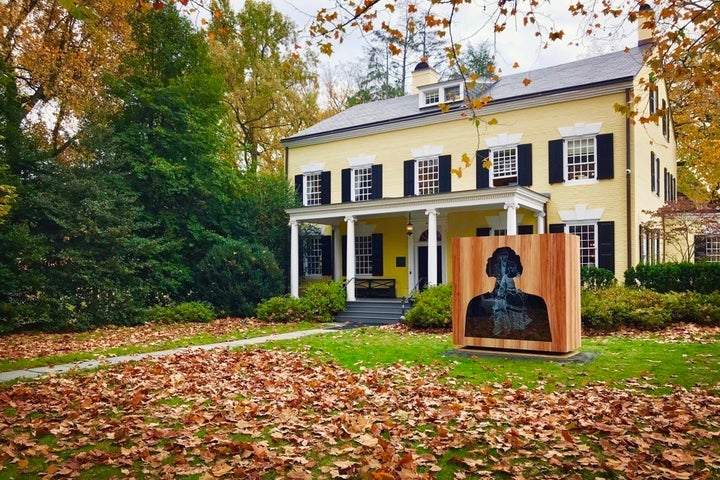
Titus Kaphar’s Impressions of Liberty
By Jacoba Urist
These days, public sculptures often seem seem intertwined with historical regret. There’s the bronze Robert E. Lee statue in Charlottesville, Virginia; the Roger Taney effigy outside the Maryland State House; the Confederate soldier in front of North Carolina’s Durham County Courthouse. This historical regret has inspired a rush to topple sculptures. But the feelings of remorse and shame have also stirred impassioned debate about the ways in which art ought to reflect America’s complex legacy: Who should embody the values of today? What distinguishes art from political propaganda? And which artists will fill the empty plinths?
Princeton University has one answer to these questions with a new public-art project that confronts the school’s participation in the nation’s early sins. On Monday, the university unveiled Impressions of Liberty, by the African American artist Titus Kaphar. The sculpture is the conceptual core of a campus-wide initiative that begins this fall and aims to reconcile the university’s ties to slavery. The Princeton and Slavery Project’s website has released hundreds of articles and primary documents about slavery and racism at Princeton, which was once jokingly described as the “northernmost outpost of Southern culture.” There is perhaps no better-suited artist than Kaphar to help the school grapple with past inequities and consider the stains of its founders. His art concentrates on the way history is remembered, highlighting the figures and inconveniences, as one 2009 Art in America review described it, who are “habitually … written out of grand historical narratives.”
Princeton is hardly the first college to reckon with the racial injustice that defined its founding, and to seek a kind of rhetorical cleansing. Georgetown, for example, announced last year that it would grant admissions preference to descendants of slaves whose sale it profited from in the early 1800s. Harvard, Brown, Emory, the University of Maryland, and the University of Virginia have also acknowledged their shameful pasts, examining through more traditional academic symposiums how slavery shapes their current environment.
But Princeton’s decision to deploy art is particularly incisive. It captures the extent to which writing the country’s history is as much an emotional process as it is a practical and cerebral one, particularly at a time when issues of historical record are far from settled. This fall, Princeton may begin confronting the wrongs of a relatively small bucolic campus. But the university presents a case study for better understanding the role contemporary art will play in how America confronts its legacy of slavery and discrimination.
Like many American institutions, Princeton shares a raw paradox with its nation: From the start, liberty and oppression were inseparable. Over the last four years, Martha Sandweiss, a Princeton history professor, has mined university and local archives to get a complete picture of the school’s links to slavery. Her research forms the basis of the Slavery Project. On the one hand, according to records, Princeton was a bastion of liberty, educating numerous Revolutionary War leaders and in 1783 hosting the Continental Congress, a pivotal moment in the country’s struggle for freedom and newfound independence. At the same time, Sandweiss found that the institution’s first nine presidents all owned slaves at some point, as did the school’s early trustees. She also discovered that the school enrolled a significant number of anti-abolitionist, Southern students during its early years; an alumni delivered a pro-slavery address at the school’s 1850 commencement ceremony.
“Like many American institutions, Princeton shares a raw paradox with its nation: From the start, liberty and oppression were inseparable.”
For the next month, Kaphar’s sculpture will occupy the lawn of Maclean House — the former home of university presidents, including Reverend Samuel Finley, who enslaved people there until his 1766 death. “Art is a language,” Kaphar told me during our first interview in his studio. “There is always a narrative coded in painting and sculpture. When you look at something, ask yourself, who is represented and who is invisible?” Impressions of Liberty, he said, is a direct response to the university’s findings that Finley’s slaves were auctioned at Maclean House. His artwork inverts the mythical hero-figure of a founding father — typical of public monuments — and the human beings Finley enslaved on campus. As with much of his art, Kaphar’s goal is to upend Old Master painting techniques to expose how images endure and shape the country’s idea of truths.
RELATED: UVA’s Troubling Past
This summer, I accompanied him on a visit to the Yale University Art Gallery, where we stood before one of his depictions of George Washington (now in Yale’s collection). This three-dimensional painting may be Kaphar’s most aesthetically compelling work yet to challenge ideals in art and U.S. history. Shadows of Libertyemploys a Colonial art tradition — an oil painting of a political leader on his proverbial white horse — but masks Washington with cascading fragments of his slave records and, in a nod to the symbolism associated with African power figures, rusty nails. Kaphar explained how Yale’s classic portraits, by the likes of John Trumbull and Thomas Eakins, inspired his reconsideration as a graduate art student of Washington the patriot and Washington the slave owner. The strips nailed to Washington, according to Pamela Franks, the gallery’s contemporary-art curator, open “new ways of understanding American history” for its museum visitors.
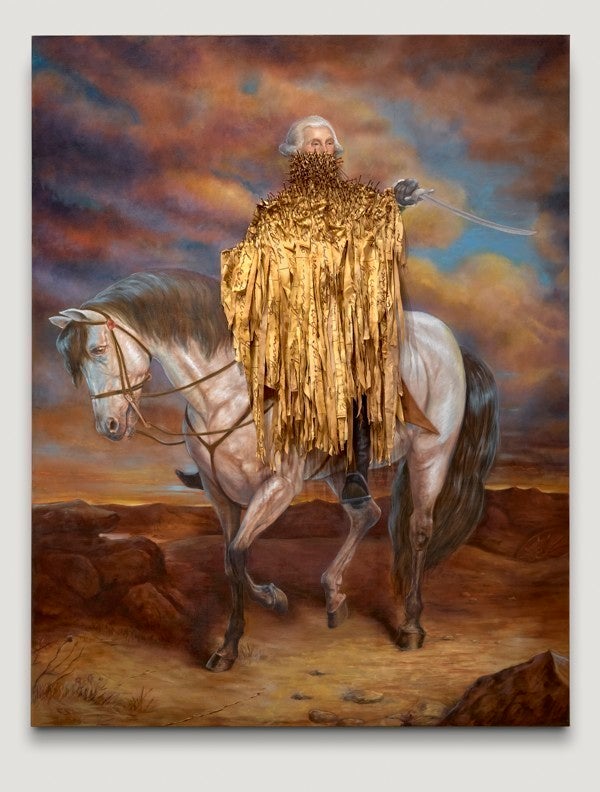
Titus Kaphar’s Shadows of Liberty, 2016, at Yale University Art Gallery (Courtesy of Titus Kaphar and Jack Shainman Gallery, New York)
In a similar vein, the piece Kaphar has sculpted for Princeton features layered photographs, etched in glass, of Finley and black actors dressed in period costumes to represent the slaves the former university president held in his campus residence. Kaphar created a composite bust in negative relief of Finley, coating it with graphite and encasing it in Sycamore wood to echo the campus’s “liberty trees” nearby, which were, according to Princeton legend, planted to commemorate the repeal of the Stamp Act.
“There are no Gods among us. I’m trying to tell the story of America without demonizing or deifying our forefathers,” Kaphar told me over phone in September, weeks after white supremacists converged in Charlottesville, Virginia, to protest the removal of the Robert E. Lee statue. His aim, Kaphar explained, is to create an experience akin to that of a manual-focus camera, that now-anachronistic device in which perspectives slide in and out of view. Kaphar does not want his work “to erase history,” but rather to ask viewers to contend with competing images in the foreground and the background — something the eye and brain struggle to do.
“There’s so much power that happens,” Kaphar said, “when we shift our focus or our gaze — just slightly, momentarily — and confront the unspoken truth.” Asked to describe his reason for back-illuminating Finley’s carved-out bust, he explained, “I’m trying to create a literal space for anyone who passes this sculpture to begin thinking about iconic leaders in history, how glorified images of the past affect the world we live in today.” For generations, slave-owning Christians — including Princeton’s founders — used religious ideas to justify a horrific national practice, he noted; Finley is holding a bible in Impressions of Liberty. But, Kaphar added, “art should never tell anyone what conversation to have. It’s not a didactic sculpture. I want people to sit with the idea that Finley doesn’t represent good or bad.”
The sculpture alone is a bold, exquisite way to visually confront what research has revealed about the school’s roots in slavery. But Princeton University is spreading the mission across various pieces of art through a show this fall entitled “Making History Visible: Of American Myths And National Heroes.” At the exhibit’s entrance, viewers begin with Kaphar’s piece Monumental Inversion: George Washington—a sculpture of the leader astride his horse, made out of wood, blown glass, and steel. The sculpture depicts the former president’s dueling nature: He’s glorified within a great American equestrian monument but he’s also sitting astride a charred cavity, surrounded by glass on the ground. In juxtaposing Kaphar’s artwork and a George Washington plaster bust, “Making History Visible” forces visitors, hopefully, to see and feel the contradiction in colonial leaders who sought freedom from tyranny but did not extend that ideal to slaves. It’s a strong lesson for any college in how a painstakingly curated exhibit can, hopefully, prompt questions about the ways society ought to remember the past, and how those decisions affect the way students understand historic truths today.
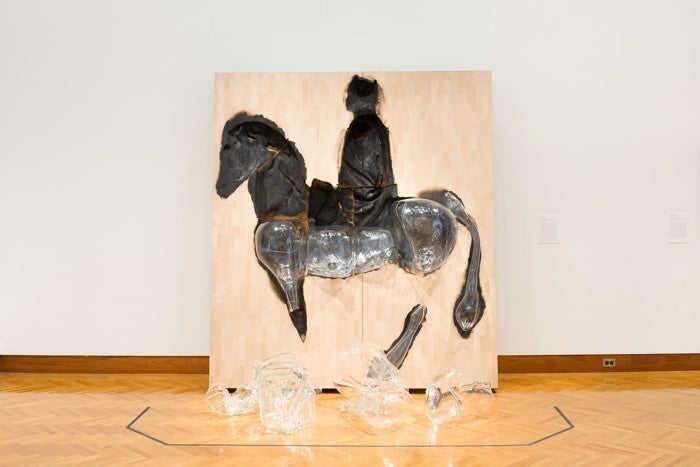
Art is about the power of symbols, according to James Steward, the museum’s director. “The conversation we are having now about monuments and their visual power are about so many of the same issues in this exhibition,” he said when asked about the country’s removed statues. “Part of our job and what Titus does is to make the past visceral.” Some museum visitors, Steward admits, have had a strong, negative response to Monumental Inversion — which he respects, at least, as an opportunity to open a dialogue.
Like anybody else, students become inured to historical names and concepts taught in the same, conventional classroom ways or frameworks, according to Bradford Vivian, the author of Commonplace Witnessing: Rhetorical Invention, Historical Remembrance, and Public Culture. A professor of communication arts and sciences at Pennsylvania State University, he described why art can provoke, in an individual, forms of reflection, interpretation, and even feeling that she hasn’t before experienced.
Kaphar describes his mission as an attempt to amend history through contemporary art. But not every such effort has succeeded. In 2011, the New York-based artist Fred Wilson met impassioned outcry — from people of all races — for his now-abandoned E Pluribus Unum public-art proposal. Invited by the Central Indiana Community Foundation to create a sculpture for the “Indianapolis Cultural Trail,” Wilson’s design reimagined the only monument in the city’s downtown depicting a black person as a new statue. The design replicated the black man, replacing his manacles with a multicolored flag, and rendering him in an elevated, assertive posture on a plinth of his own; it was to be erected blocks from the original. But local groups didn’t want an artist to critique the city’s visual history with a new sculpture near their old one; a letter published in the Indianapolis Recorder, for example, called for the art to honor one of the city’s prominent black business owners.
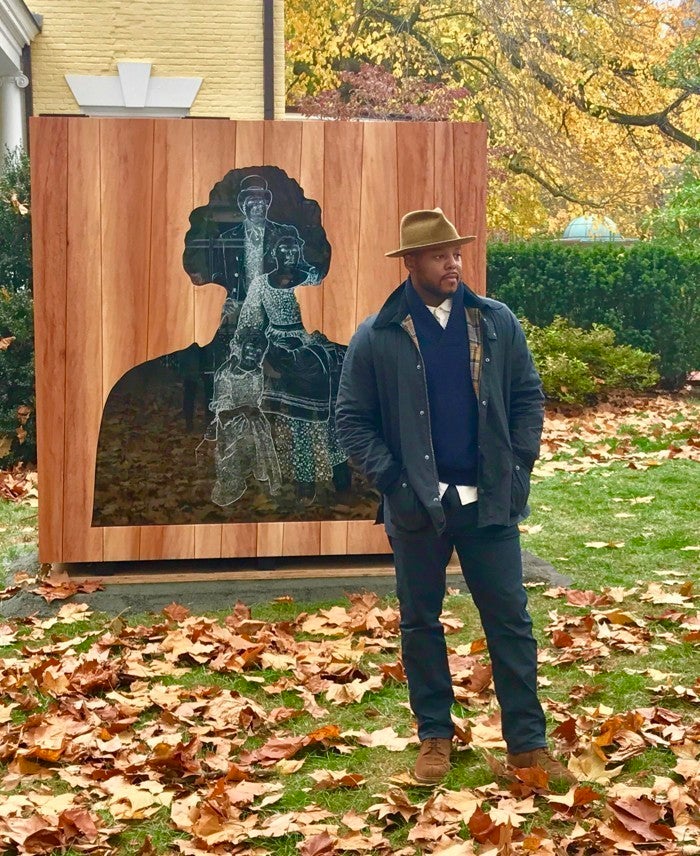
The University of California, Los Angeles, architecture professor Dell Upton, who wrote the book What Can And Can’t Be Said, has been researching monument building in the contemporary South. He cautions that the impact of Princeton’s art will prove tremendously limited if it can’t show students the vast economic tentacles between past and present. Upton pointed to Hans Haacke’s famous 1971 project, which used photographs and charts to illustrate power structures and financial entanglement in New York real estate as an example of some of the city’s most dubious landlords. Princeton’s racist history enabled it to provide social and political benefits for alumni—an advantage that students will continue to enjoy well into the future.
When Impressions of Liberty is removed from Maclean House in December and enters Princeton’s permanent museum collection, its greatest achievement may lie in the realization that no apology or recompense can ever suffice. But the potential of teaching through art is that there is also a central emotional component, an ingredient that can be missing from more standard ways of learning about one’s predecessors. “Each history deserves disruption,” the Chicago-based artist and founder of the Rebuild Foundation Theaster Gates told me, “but atoning for something is very different from grappling with it.”
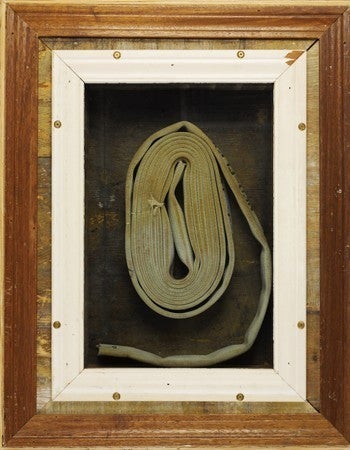
I asked Gates in October about the extent to which art can reconcile with the past. His 2011 sculpture In Case of Race Riot IIwas recently on view as part of the Brooklyn Museum’s “The Legacy of Lynching”—an attempt to spark “an honest conversation” about racial injustice in America today. In Case of Race Riot II is simplistically haunting art, a wood and metal box housing a coiled fire hose, alluding to the high-pressure water hoses police used on peaceful African American demonstrators in 1963 in Birmingham, Alabama.
“People receive information and empathy in different ways,” he explained. “No civil-rights project can ever fully redeem anything. But when we stumble upon a piece of artwork—in a museum or anywhere else we find it—we might lean in and see better through a visual language. And that language might create a bridge to understanding.”
This story originally appeared on TheAtlantic.com.
More from The Atlantic: A Catfishing With a Happy Ending, Death at a Penn State Fraternity
